The MSI MEG X570 Godlike Motherboard Review: Thor's Flagship
by Gavin Bonshor on August 28, 2019 12:00 PM EST- Posted in
- Motherboards
- AMD
- MSI
- 10G Ethernet
- Ryzen
- PCIe 4.0
- Ryzen 3000
- X570
- X570 Godlike
- MEG
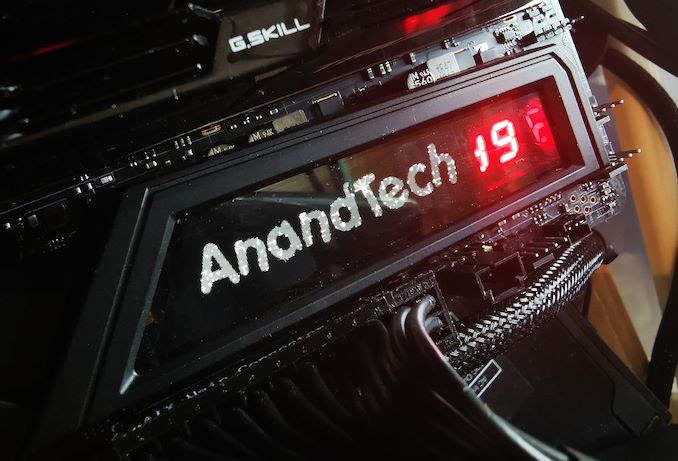
With the introduction of AMD's X570 chipset, motherboard vendors have upped its game in the premium stakes with a variety of premium mid-range and high-end models. The MEG X570 Godlike is MSI's flagship model and is heavily geared towards gamers and enthusiasts. The premium controller set of the X570 Godlike is spearheaded by Killer Networking: with dual on-board ports, Wi-Fi 6 802.11ax connectivity, and a 10 G Super LAN add-on card in the accessories bundle. Also on offer is up to five PCIe 4.0 x4 M.2 slots, two of which come from an Xpander-Z Gen4 add-on card, and a pair of Realtek ALC1220 HD audio codecs which makes this one of the most feature-rich models on the X570 chipset.
Mjolnir for X570
The MEG X570 Godlike is MSI's current flagship in its X570 line-up and represents its enthusiast gaming MEG series. Building on a similar design as the MSI MEG X570 Ace, which we have already reviewed, the X570 Godlike includes plenty of RGB options with an Infinity Mirror 2 on the rear panel cover, as well as RGB LEDs integrated into the actively cooled X570 chipset heatsink. An interesting design aspect is the customizable OLED panel to the right of the four memory slots which allows users to upload their own GIFs and animations.
There are three PCIe 4.0 x4 M.2 slots onboard with three individual M.2 heatshields, while the accessories bundle includes an M.2 Xpander-Z Gen4 PCIe 4.0 addon card which adds an additional two PCIe 4.0 x4 M.2 slots. Also included are six SATA ports with support for RAID 0, 1, and 10 arrays, while the four memory slots have support for DDR4-4800 and a total capacity of up to 128 GB.
As this is a flagship aimed at enthusiasts looking to push the Ryzen 3000 processors to its limits, cooling is important and there are a total of nine 4-pin fan headers featured around the edge of the board which are split into a single header for a CPU fan, one for a water pump, and seven for chassis fans.
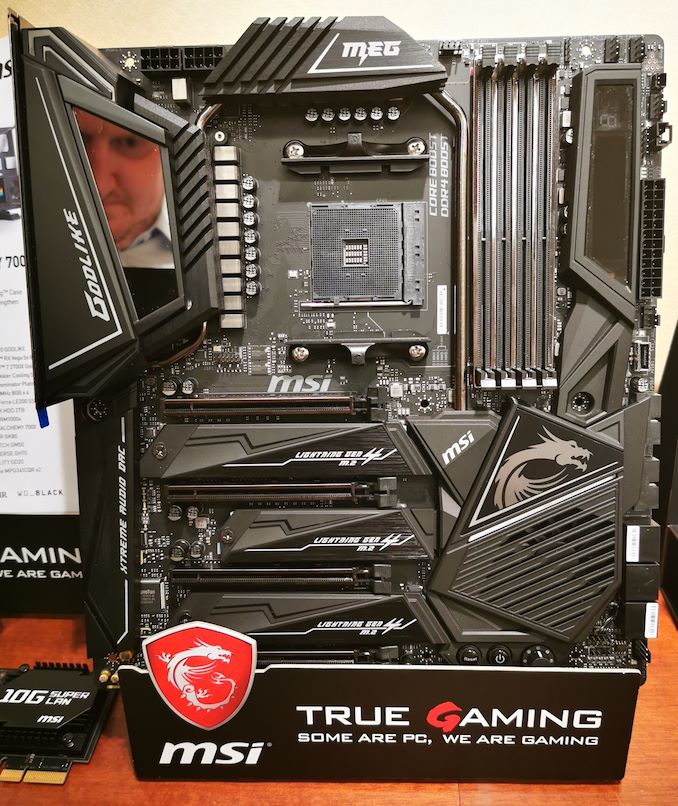
Infinity Mirror means business
Another enthusiast-level feature is a solid 14+4 phase power delivery controlled by an International Rectifier IR35201 PWM controller which operates in a 7+1 configuration. The 14-phase CPU VCore section is running with 7 x IR3599 doublers, while the 4-phase SoC section is running off a single IR3599 which splits the signal into four. This is a very capable setup with its use quality 70 A power stages throughout both sections and has already been tested on sub-zero cooling methods to great effect by some extreme overclockers. Cooling this mammoth power delivery is two large aluminium heatsinks which are interconnected by a heat pipe which also connects it to the X570 chipset heatsink.
On the lower half of the PCB is four full-length PCIe 4.0 slots, three from the CPU. These operate at x16/x0/x0/x4, x8/x0/x8/x4, and x8/x4/x4/x4, such that the fourth full-length slot is locked at PCIe 4.0 x4.
Along the bottom of the PCB is an overclockers toolkit which consists of a reset and power switch, a Game Boost overclocking profile preset dial, a pair of small buttons which allows users to overclock or downclock the base-clock in increments of 1 MHz, while a dual BIOS switch allows users to flick between two different BIOS versions; perhaps one could be set up for extreme overclocking.
MSI has included two Ethernet ports on the rear panel controlled by a Killer E3000 2.5Gbit and Killer E2600 1Gbit NIC pairing. Offering Wireless and BT 5.0 connectivity is a Killer AX1650 Wi-Fi 6 802.11ax wireless interface. Also included in the accessories bundle is an Aquantia AQC107 10 G Super Lan PCIe add-on card. Also included on the rear panel is USB 3.1 G2 connectivity with three G2 Type-A and a single Type-C G2 port, with a further two USB 3.1 G1 Type-A ports. MSI has also kitted out the MEG X570 Godlike with an impressive onboard audio solution with two Realtek ALC1220 HD audio codecs, one for the rear panel connectors, and one for the front panel. Another inclusion is an ESS 9018 Sabre DAC which powers the 6.3 mm headphone port on the rear panel. There's also a front-panel USB 3.1 G2 Type-C header, with two USB 2.0 headers which provide a total of four ports.
MSI MEG X570 Godlike Block Diagram
As expected from the number of premium controllers, the larger E-ATX form factor, and the OLED display, the MSI MEG X570 Godlike currently has the highest power draw of all the AM4 boards tested with the Ryzen 7 3700X processor so far. With both the MSI X570 Godlike and X570 Ace contending for the highest power draw, the X570 Godlike pulls over 13 W more in an idle state, and 11 W in a long idle power state. The MSI MEG X570 Godlike also has the longest POST time out of the X570 models test so far too with a default POST time of 33.9 second. In our CPU and gaming tests however, the MSI MEG X570 Godlike performed brilliantly featuring at the top of the charts across most benchmarks, albeit very marginally.
Early revisions of MSI's firmware on X570 hasn't been favorable for users looking to use the Game Boost profiles with some very questionable setting configurations; mainly too much CPU VCore which in turn, increases the heat output to dangerous levels. We have spoken to MSI and this is something they intend to fix with its next firmware update. When manually overclocking, we managed to squeeze out 4.3 GHz with a CPU VCore of 1.375; this is the brick wall for our Ryzen 7 3700X chip, and the MSI MEG X570 Godlike managed this comfortably. The performance in POV-Ray wasn't throttled as we went up each 100 MHz frequency step, and it should be noted that when overclocking on MSI's X570 models, performance isn't throttled after a certain temperature; instead, the system will shut down once CPU temperatures rise to 110ºC
The MSI MEG X570 Godlike as its name would suggest is the premier model in its line-up and as a result, is feature-laden. From its triple Killer Networking controller set, a triple-header of audio controllers, the scope for up to five PCIe 4.0 x4 M.2 slots (three onboard, two add-on), and a solid-looking 14+4 phase power delivery, the Godlike looks to be one the most comprehensive X570 motherboards on the market. Its main competition comes from the GIGABYTE X570 Aorus Xtreme ($700) and the ASUS ROG Crosshair VIII Formula ($700); both of those models also come with unique features, but the MSI MEG X570 Godlike ($700) does have four full-length PCIe 4.0 slots, capability for up to five PCIe 4.0 x4 M.2 drives out of the box, and also has plenty to offer users in aesthetics with the Mystic Light Infinity Mirror 2, and the customizable OLED panel.


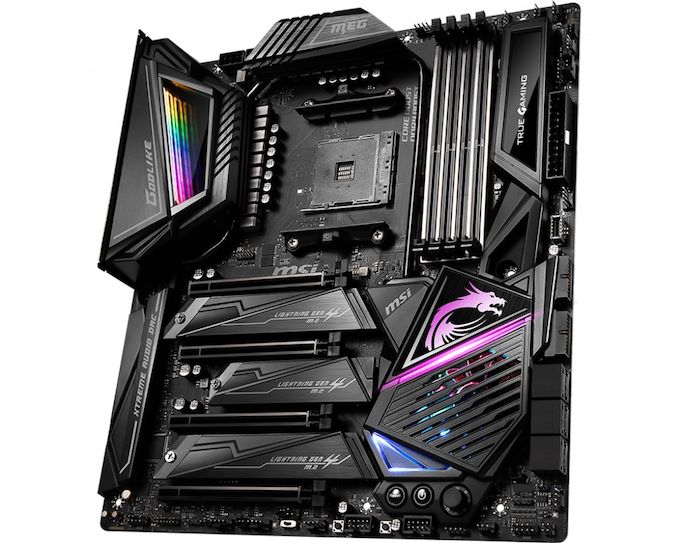



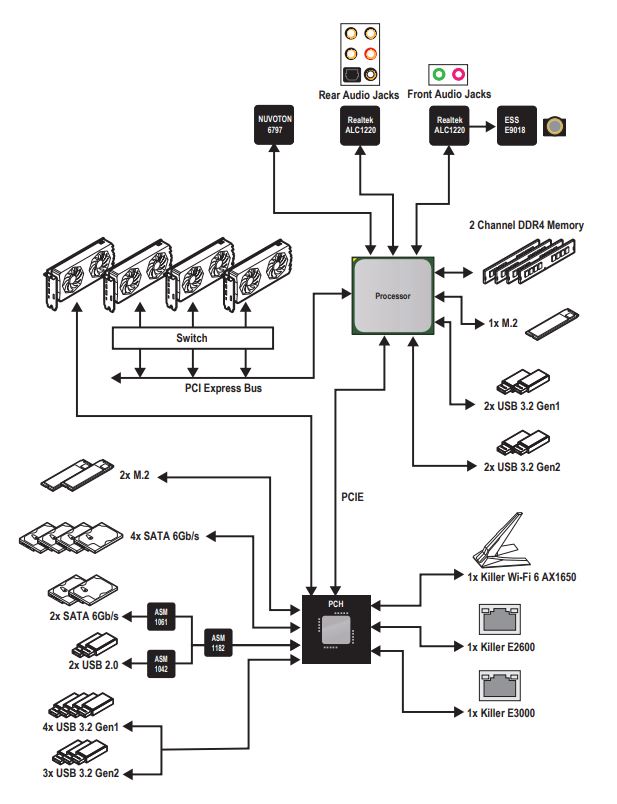
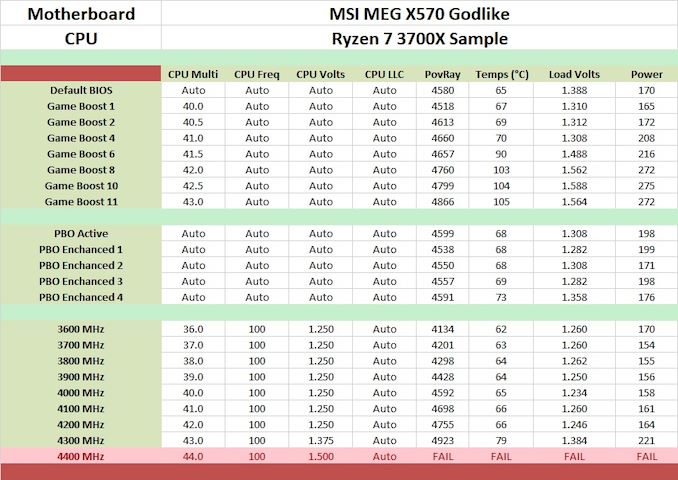








116 Comments
View All Comments
WaltC - Thursday, August 29, 2019 - link
Not to mention an old architecture Intel's been milking for years that is full of security holes and software & bios patches, etc. Nah, the longevity argument and bang-for-the-buck argument is won by AMD this time, decisively.Oliseo - Thursday, August 29, 2019 - link
"Not to mention an old architecture Intel's been milking for years that is full of security holes and software & bios patches, etc. Nah, the longevity argument and bang-for-the-buck argument is won by AMD this time, decisively."Be careful of comments like this. They may come back to haunt you. Just because there seems to be no security issues in AMD does not mean they don't exist.
After all, it's not like you were screaming about spectre a couple of years ago, was you.
Oxford Guy - Thursday, August 29, 2019 - link
Reality is that people buy what's available today. Today, there are more security problems with Intel than with AMD.Today, Intel has a worse track record for security robustness.
However, I will say that both companies embed black boxes into their chips. AMD stripped PSP for China, presumably to add a different black box.
29a - Friday, August 30, 2019 - link
Is the next Ryzen using the same socket?Qasar - Friday, August 30, 2019 - link
given AMD's track record for upgrade ability, its quite possible, it could.Threska - Saturday, August 31, 2019 - link
Future Proofing? So that means we've finally gotten something definite about 2020 forward on socket AM4, and PCI 5.Peter2k - Thursday, August 29, 2019 - link
Or buy a solid X570 for way less and still get an all core of 4.2The difference you achieve with pricier boards is negliable really, AMD or Intel
Also I have no idea why you're bashing and then referring to Intel in this regard, you can easily buy a 700$, or even 1000$ Z390
Sweetbabyjays - Thursday, August 29, 2019 - link
"get an all core of 4.2" according to silicon lottery's statistics, only the top 21% of their 3700x cpu's tested could get to 4.15GHz (all core). So to get a guaranteed 4.2 you need to get a 3800x.I agree that the difference with pricier boards is negligible, really your silicon is more determinate of your max OC than your motherboard.
The reason I'm bashing (this $700 motherboard specifically) is because if you're willing to dump $700 on a motherboard in the pursuit of performance you can literally pay that $700 for a cpu and motherboard combo(the 9900k and a Z390 board) that destroys the performance of the 3700x (the one tested in the article) and any motherboard.
If you compare product level to product level you will find that the X570 price vs Z390 version of say the Gigabyte AORUS XTREME or the MSI MEG Godlike, is ~ $150 and $100 respectively more expensive for the X570 version.
If you need an 8c/16t cpu and you're after the highest performance overclocked option, why pay more for a 3700x/X570 for less performance than a 9900k/Z390?
AshlayW - Thursday, August 29, 2019 - link
Dude where are you getting that 3700X/X570 costs more than 9900K/Z390? The CPU alone is like 150 bucks cheaper, and decent X570s are around 150-200 bucks, the same as decent Z390s. You also have to buy the cooler for the Blast Furnace 9900K to get it anywhere near those "4.8GHz" clocks you're going to need another 50 bucks on a cooler, whereas the 3700X can use its included Prism easily. By your own admission "5-10%" performance isn't worth it, so why pay 150-200 bucks more for a less efficient, dead-end, security vulnerability ridden product based on tech from 2015, when you can have 90% its performance with the latest features including PCIE4.0, for less money?I'm sorry mate but you're not making sense or you're delusional. Please don't spread misinformation, and I suggest people go to their favourite retailer/store and check prices if they want to confirm it themselves.
Sweetbabyjays - Thursday, August 29, 2019 - link
Ashlay you need to cool your jets broseph.The first section of my comment is referring to how pointless this $700 board is when you can spend that $700 and get a Z390 and 9900k that will beat the cpu tested in the article (3700x) on this monstrosity of a board.
Then I commented how X570 in general has an inflated cost that really hurts the value proposition of the Ryzen CPUs when you compare model tier to model tier.
As per PC Partpicker:(my source wasn't mentioned, so sorry for not saying that)
MSI X570 Godlike $689.99
MSI Z390 Godlike $578.86
Difference: ~$111
Gigabyte X570 AORUS XTREME $706.98
Gigabyte Z390 AORUS XTREME $549.99
Difference: ~$150
To get the 9900k to 4.8 is really very little effort at all and most can go there with 1.25V which again is pretty tame and hardly creates the "furnace" you're talking about. Yes at 5.1 GHz and say 1.4V the 9900k is probably excellent for tempering swords and casting iron. The 3700x can use it's stock cooler easily, at stock speeds, I totally agree, but once you get that overclock going, you are going to need a better cooler, note the temps above are with 240mm AIO on the 3700x.
I'm not going to argue with the efficiency, because AMD did quite well in that regard with their 7nm process, it clearly is more power efficient.
As far as security issues they have both had their own issues over the years, although Intel has had a fair amount more.
I think though you really hammer the point i am making home with your statement "...product based on tech from 2015, when you can have 90% its performance..."
Intel tech from 2015 is still 10% better performing than AMD's best and newest tech in 2019.
Then you say in another comment "they've won the performance and value games both at once." i never knew 10% less performance is better.
As for PCIE 4.0 if AMD has big Navi coming that can actually outperform a PCIE 3.0 x16 slot's bandwidth then I will be the first in line to get a 3900x and x570. But until there is a single card that is limited by PCIE x16 I personally don't see any reason for it. Sure ridiculously fast nvme drives are nice, but again, they don't do a whole lot to improve gaming or most workflows.